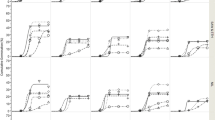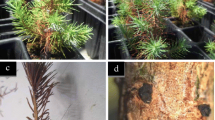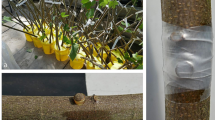Abstract
During establishment and subsequent growth, corticolous lichen fungi are subjected to the chemical composition and pH of the stemflow, which depend on the water-soluble compounds released from the bark. The present study explored the use of spore-shot isolation to test the effect of bark extracts on germination and initial mycelium growth. The pH, phenolic content and glucose equivalents of the bark extracts were also related to spore germination. Bark samples from Acer pseudoplatanus, Alnus glutinosa, Betula pendula, Fagus sylvatica, Fraxinus excelsior, Quercus robur and Tilia cordata were collected at two heights. We extracted water-soluble compounds and isolated fungal spore groups from Xanthoria parietina (L.) Th. Fr. in vitro on water agar mixed with extracts. Spores germinated and grew on pure water agar (control) and media with extracts from Acer, Betula and Fagus. Growth was significantly lower on Acer than on Betula, Fagus and controls. No germination took place on the remaining media suggesting a strong inhibitory effect of Fraxinus, Quercus, Tilia and Alnus. Germination occurred within a week and was an all-or-none response. The mycelia grew slowly, and diameters within 90 days ranged from 0.25 to 3.05 mm. All bark extracts that allowed germination showed a pH above 5.1 and relatively low amounts of phenols and glucose equivalents. This suggests that low pH and strong concentrations of dissolved compounds in the stemflow may prevent lichen colonisation. This method can be variously applied for studying behaviour of dispersed lichen spores.




Similar content being viewed by others
Availability of data and material
Primary data for this study will be stored in the repository Data DOI at the University of Copenhagen.
References
Ahmadjian V (1993) The lichen symbiosis. John Wiley and Sons, Inc. New York
Asplund J, Ohlson M, Gauslaa Y (2015) Tree species shape the elemental composition in the lichen Hypogymnia physodes transplanted to pairs of spruce and beech trunks. Fungal Ecol 16:1–5
Beck A, Mayr C (2012) Nitrogen and carbon isotope variability in the green-algal lichen Xanthoria parietina and their implications on mycobiont–photobiont interactions. Ecol Evol 2:3132–3144
Behera BC, Verma N, Sonone A, Makhija U (2006) Experimental studies on the growth and usnic acid production in “lichen” Usnea ghttensis in vitro. Microbiol Res 161:232–237
Bubrick P, Galun M, Frensdorff A (1984) Observations on free-living Trebouxia De Puymaly and Pseudotrebouxia Archibald, and evidence that both symbionts from Xanthoria parietina (L.) Th. Fr. can be found free-living in nature. New Phytol 97:455–462
Bubrick P, Galun M (1986) Spore to spore resynthesis of Xanthoria Parietina. Lichenologist 18:47–49
Cáceres MES, Lücking R, Rambold G (2007) Phorophyte specificity and environmental parameters versus stochasticity as determinants for species composition of corticolous crustose lichen communities in the Atlantic rain forest of northeastern Brazil. Mycol Prog 6:117–136
Callaway RM, Reinhart KO, Moore GW, Moore DJ, Pennings SC (2002) Epiphyte host preferences and host traits: mechanisms for species-specific interactions. Oecologia 132:221–230
Chrismas M (1980) Ascospore discharge and germination in Xanthoria parietina. Lichenologist 12:403–406
Cordeiro LMC, Iacomini M, Stocker-Wörgötter E (2004) Culture studies and secondary compounds of six Ramalina species. Mycol Res 108:489–497
Crittenden PD, David JC, Hawksworth DL, Campbell FS (1995) Attempted isolation and success in the culturing of a broad spectrum of lichen-forming and lichenicolous fungi. New Phytol 130:267–297
Ellis CJ (2012) Lichen epiphyte diversity: a species, community and trait-based review. Perspect Plant Ecol 14:131–152
Ellegård Larsen HM, Hansen ES, Nord-Larsen T, Rasmussen HN (2020) Deciduous trees as lichen phorophytes: biodiversity and colonization patterns under common garden conditions. Lichenologist 52:221–232
Fanning E, Ely JS, Lumbsch HT, Keller HW (2007) Vertical distribution of lichen growth forms in tree canopies of Great Smoky Mountains National Park. Southeast Nat 6:83–88
Favero-Longo SE, Piervittori R (2010) Lichen–plant interactions. J Plant Interact 5:163–177
Fortuna L, Tretiach M (2018) Effects of site-specific climatic conditions on the radial growth of the lichen biomonitor Xanthoria parietina. Environ Sci and Pollut R 25:34017–34026
Fritz Ö (2009) Vertical distribution of epiphytic bryophytes and lichens emphasizes the importance of old beeches in conservation. Biodivers Conserv 19:745–760
Gauslaa Y (1985) The ecology of Lobarion pulmonariae and Parmelion caperatae in Quercus dominated forests in south-west Norway. Lichenologist 17:117–140
Gauslaa Y, Ohlson M, Rolstad J (1998) Fine-scale distribution of the epiphytic lichen Usnea longissima on two even-aged neighbouring Picea abies trees. J Veg Sci 9:95–102
Halama P, Van Haluwin C (2004) Antifungal activity of lichen extracts and lichenic acids. BioControl 49:95–107
Hill DJ, Woolhouse HW (1966) Aspects of the autecology of Xanthoria parietina agg. Lichenologist 3:207–214
Honegger R (1998) The lichen symbiosis – what is so spectacular about it? Lichenologist 30:193–212
Jeon H-S, Lökös L, Han KS, Ryu J-A, Kim JA, Koh YJ, Hur J-S (2009) Isolation of lichen-forming fungi from Hungarian lichens and their antifungal activity against fungal pathogens of hot pepper anthracnose. Plant Pathology J 25:38–46
Jüriado I, Liira J, Paal J, Suija A (2009) Tree and stand level variables influencing diversity of lichens on temperate broad-leaved trees in boreo-nemoral floodplain forests. Biodivers Conserv 18:105–125
Király I, Nascimbene J, Tinya F, Ódor P (2013) Factors influencing epiphytic bryophyte and lichen species richness at different spatial scales in managed temperate forests. Biodivers Conserv 22:209–223
Kofler L (1970) A method to use lichen spores in quantitative studies on germination. Bryologist 73:602–606
Koopmann R (2005) Allelopathic effects of bark phenols on epiphyte lichens. Rheinischen-Friedrich-Wilhelms Universität Bonn, Dissertation
Koopmann R, Stevens H, Franzen-Reuter I, Frahm J, Grote M (2007) In vitro inhibition of soredial growth in the epiphytic lichen Physcia tenella (Ascomycetes: Lecanorales) by a variety of bark phenols. Lichenologist 39:567–572
Kubiak D, Osyczka P (2020) Non-forested vs forest environments: the effect of habitat conditions on host tree parameters and the occurrence of associated epiphytic lichens. Fungal Ecol 47:100957
Kulbat K (2016) The role of phenolic compounds in plant resistance. Biotechnol and Food Sci 80:97–108
Kuusinen M (1996) Epiphytic flora and diversity on basal trunks of six old-growth forest tree species in southern and middle boreal Finland. Lichenologist 28:443–463
Käffer MI, Marcelli MP, Ganade G (2010) Distribution and composition of the lichenized mycota in a landscape mosaic of southern Brazil. Acta Bot Bras 24:790–802
Lamit LJ, Lau MK, Næsborg RR, Wojtowicz T, Whitham TG, Gehring CA (2015) Genotype variation in bark texture drives lichen community assembly across multiple environments. Ecology 96:960–971
Lever M (1973) Colometric and fluorometric carbohydrate determination with p-hydroxybenzoic acid hydrazide. Biochem Med Metab B 7:274–281
Luo H, Yamamoto Y, Jeon H-S, Liu YP, Jung JS, Koh YJ, Hur J-S (2011) Production of anti-Helicobacter pylori metabolite by the lichen-forming fungus Nephromopsis pallescens. J Microbiol 49:66–70
Luo H, Li C, Kim JC, Liu Y, Jung JS, Koh YJ, Hur J-S (2013) Biruloquinone, an acetylcholinesterase inhibitor produced by lichen-forming fungus Cladonia macilenta. J Microbiol Biotechnol 23:161–166
Makkar HPS (2003) Measurement of total phenolics and tannins using Folin–Ciocalteu method. In: Makkar HPS (ed) Quantification of tannins in tree and shrub foliage. A laboratory manual. Vienna, Austria, Springer pp 49–51
Marmor L, Tõrra T, Saag L, Randlane T (2010) The vertical gradient of bark pH and epiphytic macrolichen biota in relation to alkaline air pollution. Ecol Indic 10:1137–1143
Meeßen J, Eppenstein S, Ott S (2013) Recognition mechanisms during the pre-contact state of lichens: II. Influence of algal exudates and ribitol on the response of the mycobiont of Fulgensia bracteata. Symbiosis 59:131–143
Molina MC, Stocker-Wörgötter E, Türk R, Vicente C (1997) Axenic culture of the mycobiont of Xanthoria parietina in different nutritive media: effect of carbon source in spore germination. Endocyt Cell Res 12:103–109
Molina MC, Crespo A (2000) Comparison of development of axenic cultures of five species of lichen-forming fungi. Mycol Res 104:595–602
Molina MC, Divakar PK, González N (2015) Success in the isolation and axenic culture of Anaptycia ciliaris (Physciaceae, Lecanoromycetes) mycobiont. Mycoscience 56:351–358
Munzi S, Branquinho C, Cruz C, Loppi S (2013) Nitrogene tolerance in the lichen Xanthoria parietina: the sensitive side of a resistant species. Funct Plant Biol 40:237–243
Nimis PL, Martellos S (2016) The lichens of Italy. A second annotated catalogue, EUT, Trieste
Olsen HB, Berthelsen K, Andersen HV, Søchting U (2010) Xanthoria parietina as a monitor of ground-level ambient ammonia concentrations. Environ Pollut 158:455–461
Ostrofsky A, Denison WC (1980) Ascospore discharge and germination in Xanthoria parietina. Mycologia 72:1171–1179
Ott S (1987) Sexual reproduction and developmental adaptations in Xanthoria parietina. Nord J Bot 7:219–228
Pyatt FB (1969) Studies of the periodicity of spore discharge and germination in lichens. Bryologist 72:48–53
Rambo TR (2010) Structure and composition of corticolous epiphytes communities in Sierra Nevada old-growth mixed-conifer forest. Bryologist 113:55–71
Rasmussen HN, Nord-Larsen T, Hansen ES, Hoareau G (2018) Estimation of life history in corticolous lichens by zonation. Lichenologist 50:697–704
Rosabal D, Burgaz AR, Reyes OJ (2013) Substrate preferences and phorophyte specificity of corticolous lichens on five tree species of the montane rainforest of Gran Piedra, Santiago de Cuba. Bryologist 116:113–121
Rosabal D, Burgaz AR, Reyes OJ (2014) Lichen species co-occurrence patterns on five tree species of the montane rainforest of Gran Piedra, Santiago de Cuba. Bot Complut 38:97–104
Sales K, Kerr L, Gardner J (2016) Factors influencing epiphytic moss and lichen distribution within Killarney National Park. Biosci Horiz 9:1–12
Schaper T, Ott S (2003) Photobiont selectivity and interspecific interactions in lichen communities. I. Culture experiments with the mycobiont Fulgensia bracteata. Plant boil 5:441–450
Schmull M, Hauck M (2003) Element microdistribution in the bark of Abies balsamea and Picea rubens and its impact on epiphytic lichen abundance on Whiteface Mountain, New York. Flora 198:293–303
Smith CW, Aptroot A, Coppins BJ, Fletcher A, Gilbert OL, James PW, Wolseley PA (2009) The lichens of Great Britain and Ireland, Second edn. British Lichen Society, London
Solberg Y (1979) Studies on the chemistry of lichens, XX. The element concentration of lichen species Alectoria fremontii and its associated bark substrate of Pinus silvestris. Z Naturforsch C 34:1275–1277
Stocker-Wörgötter E (1995) Experimental cultivation of lichens and lichen symbionts. Can J Botany 73:579–589
Verma N, Behera BC, Joshi A (2012) Studies on nutritional requirements for the culture of lichen Ramalina nervulosa and Ramalina pacifica to enhance the production of antioxidant metabolites. Folia Microbiol 57:107–114
Verma N, Behera BC (2015) In vitro cultures of lichen partners: need and implications. In: Upreti D, Divakar P, Shukla V, Bajpai R (eds) Recent advances in lichenology. Springer, New Delhi, pp 147–159
Yamamoto Y, Mizuguchi R, Yamada Y (1985) Tissue cultures of Usnea rubescens and Ramalina yasudae and production of usnic acid in their cultures. Agric Biol Chem 49:3347–3348
Yamamoto Y, Miura Y, Higuchi M, Kinoshita Y, Yoshimura I (1993) Using lichen tissue cultures in modern biology. Bryologist 96:384–393
Yamamoto Y, Kinoshita Y (1998) Factors affecting discharge and germination of lichen ascospores. J Hattori Bot Lab 85:267–278
Yoshimura I, Yamamoto Y, Nakano T, Finnie J (2002) Isolation and culture of lichen photobionts and mycobionts. In: Kranner IC, Beckett RP, Varma AK (eds) Protocols in lichenology. Springer Lab Manuals. Heidelberg, Berlin, Springer, pp 3–33
Acknowledgements
We are very grateful to 15. Juni Fonden (Grant/Award number 2015-A-4A) and the foundation Godfred Birkedal Hartmanns Familiefond (Grants of 18 May 2016 ‘Water household in bark’ and 23 May 2017 ‘Bark as habitat’) who supported this study. Great thanks are due to Radina Tokin, who was an indispensable help during the measurements of phenolic content and glucose equivalents in the bark extracts. Great thanks are also due to Eric Steen Hansen for his help with verification of the collected lichen material and to Thomas Nord-Larsen, Torben Riis-Nielsen and Sebastian Kepfer Rojas for their statistical advice.
Funding
This study was supported by 15. Juni Fonden (Grant/Award number 2015-A-4A).
Author information
Authors and Affiliations
Contributions
H.N.R. conceived the study and designed the experimental setup together with H.M.E.L. H.M.E.L. collected the data and made the statistical analysis. H.M.E.L. and H.N.R. wrote and revised the manuscript together.
Corresponding author
Additional information
Section Editor: Gerhard Rambold
Publisher’s Note
Springer Nature remains neutral with regard to jurisdictional claims in published maps and institutional affiliations.
Rights and permissions
About this article
Cite this article
Larsen, H.M.E., Rasmussen, H.N. Bark extract influence on spore germination in corticolous lichen Xanthoria parietina in vitro. Mycol Progress 20, 313–323 (2021). https://doi.org/10.1007/s11557-021-01673-0
Received:
Revised:
Accepted:
Published:
Issue Date:
DOI: https://doi.org/10.1007/s11557-021-01673-0




